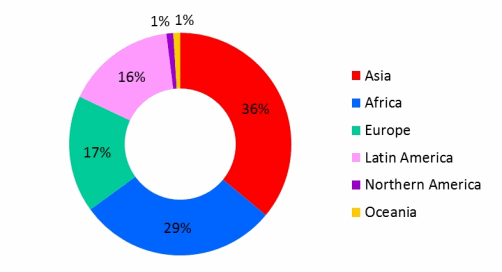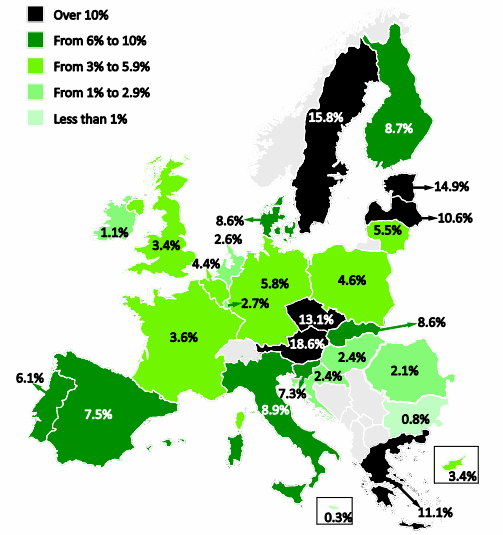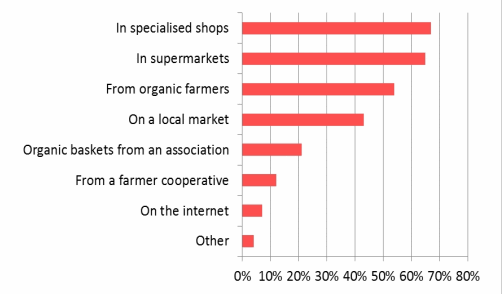


Organic production is an overall system of farm management and food production that aims at sustainable agriculture, high-quality products and the use of processes that do not harm neither the environment, nor human, plant or animal health and welfare.
Consumers are anxious about food quality, production techniques and provenance and they trust organic foods more easily. The food-related decision-making process is complex and is influenced by many determinants:
A public consultation on organic agriculture highlighted the public's concerns with environmental and quality issues, and showed a clear demand for strengthened and more uniform organic rules (86%), and improved control systems (58%).
To help consumers make an informed choice, the European Commission, added to existing legislation and set up an extensive framework of rules and requirements on the production, processing, handling and certification of organic foods and introduced a specific EU organic logo (see below).
Various terms such as 'bio', 'eco' and 'organic' are used to refer to organic products. The term 'bio/biological' prevails in Latin and Germanic languages. English-speaking countries mostly use the term 'organic'.
More specifically, the term 'organic' refers to an overall system of farm management and food production that aims at sustainable agriculture, high –quality products and the use of processes that do not harm the environment, and human, plant or animal health and welfare.
However, these widely used terms in food marketing have a variety of definitions, most of which are vague and assumed to imply foods that are minimally processed and all of whose ingredients are natural products.
Organically grown foods are indeed not to be confused with foods sold as 'natural'. In the United States of America (USA) for example, the term 'organic' can be used for certified organic products, while the label 'all-natural' is a legally unregulated expression.
While the sustainable nature of organic farming is generally accepted, its health and nutritional benefits are still widely debated. The use of (organic) pesticides and the possible presence of residues in organically grown crops also attract a lot of attention. A difficulty comes from the fact that, when assessing the results of existing studies, at least three different aspects are treated simultaneously:
From a strictly nutritional perspective, scientists have found little advantage in organic foods. In 2012, a deep review of 240 studies found that organic foods were not significantly more nutritious than their conventionally grown counterparts. For nutrition experts, the endless debate on the benefits of organic produce is just a distraction from the real issue at hand, which is that a majority of Europeans do not reach the recommendations of the World Health Organization (WHO) on a daily consumption of vegetables and fruit of any type – around 400 g per day – which is a more pressing concern.
From a health perspective, the level of pesticide residues was found to be lower among organic produce and a more recent study from 2014 revealed fewer pesticide residues, and 20% to 40% higher levels of antioxidants in organically grown crops. It is however unclear whether antioxidants can improve human health, and their precise role is still being debated.
From an environmental perspective, practitioners assert that the best reason to buy organic food is for the lower impact and sustainable production values, and that any nutritional benefit should simply be considered a 'bonus'.
Organic agricultural practice is environmentally sustainable by nature. Soil-building techniques such as crop rotation and minimum tillage preserve soil fauna and flora, improve soil formation and structure, and avoid soil erosion. Many management practices used by organic agriculture increase the return of carbon to the soil, raising productivity and favouring carbon storage. The more organic carbon is retained in the soil, the higher the climate-change mitigation potential of agriculture.
The use of organic fertilisers (e.g. compost, animal manure, green manure) and greater biodiversity (in terms of species cultivated and permanent vegetation) also enhance soil structure and water infiltration which, in turn, reduce the risk of groundwater pollution.
Moreover, traditional and adapted seeds and breeds are preferred for their greater resistance to diseases and their resilience to climatic stress. Finally, the maintenance of natural areas within and around organic fields, together with the absence of chemical inputs, preserve habitats for wildlife.
Meanwhile, organic farming has not necessarily positive impacts on the environment per product unit. Yield differences may range from 5% to 34%. If Europe tried to feed itself exclusively through organic agriculture (at constant consumption), it would need an additional million hectares. In terms of climate impact and greenhouse gas (GHG) emissions, organic milk, cereals and pork production generate higher GHG emissions per unit of output than the conventional alternative. However, when multi-cropping and crop rotation are applied in organic systems diversification, these practices substantially reduce the yield gap with non-organic management practices to about 9%.
On the other hand, consumers having a preference for organic food are also more environmentally conscious and may have more sustainable dietary habits food, eat less meat and therefore contribute less to high land-consumption and GHG emissions.

The principles governing organic food in the European Union (EU) are defined in Regulation No 834/2007 and Regulation No 889/2008 on organic production and labelling. This method of production pursues the respect of nature's systems and cycles, a high level of biodiversity, responsible use of energy and natural resources such as water, soil, organic matter and air, and high animal welfare standards.
The introduction of an EU logo in 2010 does not prevent the simultaneous use of national or private logos, and aims to create more clarity for EU consumers. However, a 2013 poll showed that it was recognised by only 25% of Europeans.
The EU Regulation on organic production and labelling specifies that any terms, derivatives or diminutives – such as 'bio' and 'eco' alone or combined – suggesting that a product or its ingredients have been obtained through an organic method of production, may be used in any official EU language for the labelling and advertising of products. Foods may be labelled as 'organic' if at least 95% of their agricultural ingredients are organic. In order to market products as organic and use the EU logo, farmers, processors and traders must comply with the following EU requirements:
Organic food has to be preferably processed with the use of biological, mechanical and physical methods and in non-organic foods, any ingredients which meet organic standards can be listed as organic.
The use of genetically modified organisms (GMOs), and of products derived from or produced by GMOs (with the exception of veterinary medicinal products) is strictly forbidden during any stage of production, processing or handling.
The existing EU labelling thresholds represent ceilings which are linked only to the accidental and technically unavoidable presence of GMOs.
The Regulation on genetically modified food defines a threshold of 0.9%, under which a product's GMO content does not have to be indicated and the product can be labelled as 'organic'. In other words, it is not possible to label a product as organic if it contains 1% or more of GMOs.
However, with increasing GMOs use in conventional agriculture and due to the possible risk of transmission of GMOs in the environment (e.g. through pollen), it will become difficult for organic agriculture to ensure that organic products are completely GMO free in the future.
Animal welfare is an important requirement in organic livestock production. There are strict rules on the way in which animals are housed, in terms of space, air and light. Tethering animals is not allowed unless it is essential for safety, welfare or veterinary reasons.
Any suffering is kept to a minimum throughout the animal's life and their welfare must be guaranteed during transport. The use of any type of electrical stimulation or tranquilisers before or during loading and unloading is strictly forbidden. Slaughter methods are designed to be as quick and painless as possible. However, animal welfare associations have stressed that some ill-defined provisions and inappropriate practices must be redesigned and improved.
Chemically synthesised medicines including antibiotics may be used under strict conditions and only when the use of phytotherapeutic or homeopathic products is inappropriate. Cloning and/or transferring embryos is also forbidden. Hormones or similar substances are only allowed as a veterinary therapeutic treatment in an individual animal.
Practitioners claim that organic food-production systems rely essentially on preventive measures. The primary form of pest control in organic farming is carried out mainly through a number of fundamental practices including crop rotation, maintenance of biodiversity and optimum crop health, and the use of resistant varieties. In general, organic growers tend to privilege the use of biological control agents, namely parasites of pests, released into the crop area.
However, the use of a certain number of organic pesticides is allowed in EU organic farming. Some argue that pesticides used in organic agriculture are not safer than synthetic ones, others stress that most organic pesticides have a small persistence in the environment and are, therefore, unlikely to leave residues in food.
The results of the European Food safety Agency (EFSA) 2013 report showed that organically produced food less frequently contained pesticide residues exceeding the limits (0.8% of the samples), compared to products produced conventionally (2.7%). The most frequently quantified pesticide was copper.
Last, but not least, while taking synthetic pesticides out of food production reduces hazards to the environment and consumers, this is not the case for farmworkers. Scientists assert that compared with the general population, the rates for some types of cancer, appear to be higher among farmers, which 'may be related to exposures that are common in their work environments'.
To be allowed to use the EU organic logo and label their products as 'organic', farmers, processors and traders must comply with EU requirements. EU Member States may opt to set up a public, private or mixed control system and designate one or more competent authorities responsible for controls. Competent authorities are required to organise audits or inspections of control bodies and, where needed, withdraw approval of control bodies that fail to satisfy the requirements.
Meanwhile, the control system as set out by the Commission aims at guaranteeing the production processes but not the organic character of the products themselves, since there is no scientific way to determine whether a product is organic or not.
Control checks are carried out at every stage of the organic chain. Every operator – farmer, processor, trader, importer or exporter, with the exception of wholesalers dealing with pre-packaged products – is checked at least once a year or more, often on the basis of risk assessment. Organic products should bear the name of the producer, processor or distributor who last handled the item, the name or code number of the national certification authority, and the EU control authority.
In 2012, the European Court of Auditors recommended in its special report that the competent authorities should strengthen their supervisory role over control bodies, notably by promoting harmonisation in the definition of infringements, irregularities and corresponding sanctions.
Regarding imports and exports of organic food products, the EU regulates also organic products from third countries. These can be imported from non-EU countries whose rules on organic production and control are equivalent to the EU's. Currently, agreements exist with Argentina, Australia, Canada, Costa Rica, India, Israel, Japan, Korea, New Zealand, Tunisia, Switzerland and the USA.
The EU has also secured recognition of EU organic rules in several important export markets including Australia, Japan, Switzerland, Canada and the USA. For all other non-EU countries, importers can have their organic products certified for import into the EU by independent private control bodies approved by the European Commission.
The cost of certified organic foods is generally higher than the price of their conventional counterparts. There are various reasons which account for this difference:

In 2013, organic farmland only accounts for 1% of total worldwide farmland. (over 43 million hectares) in 170 countries. The continent with the largest organic agricultural area is Oceania, by 98% in Australia and mainly used as grazing area for the production of organic beef. It is followed by Europe, Latin America), Asia, North America, and Africa.
Over the past 30 years, international sales of organic foods have grown from almost nothing, to over €66 billion (US $72 billion) in 2013. Demand is mainly concentrated in two world regions: North America and Europe and the global market for organic products continues to grow. The largest single market for organic food is the USA (€24.3 billion) followed by the EU (€22 billion and 10 million ha or 5.7% of the EU's agricultural area in 2013) and China (€2.4 billion) – a country for which official retail sales data became available for the first time in 2014.
Demand is mainly concentrated in North America and Europe. However, over ¾ of the nearly 2 million organic producers worldwide are in Asia, Africa, and Latin America and this accounts for the imbalances in international trade of organic products, which is one of the most pressing issues facing global organic trade. For example when organic rice, soya beans, fruits and spices are exported from Asia to Europe, and then re-exported to Asian markets as finished organic products, this not only has negative impact on their environmental footprint, but also inflates retail prices for consumers.
In recent years, in spite of the economic crisis and the fact that organic food is more expensive than conventional ingredients, more and more consumers prompted mainly by environmental concerns are taking the organic food option. The EU continues to be a forerunner in organic agriculture thanks to this strong consumer demand, strict legal protection and support for organic production.

Germany is the largest EU market (€7 billion) followed by France (€4 billion), the United Kingdom (UK, €2 billion), and Italy (€2 billion). Even if care must be taken in interpreting figures as the costs of living differ quite considerably across countries, the highest per-capita consumption in 2013 would have been reached in Denmark (€164), Luxembourg and Austria.
The vast majority of Europeans buy their organic products in specialised shops (67%) and supermarkets (65%) even if the financial crisis slowed down sales growth in some countries.

Certain products are more in demand than others:
Globally, the EU continues to be a pioneer in organic agriculture and production due to strong consumer demand, strict legal protection and requirements for organic production and labelling as well as support for organic production. Italy is the country with the largest number of organic producers (46 000), followed by Spain (30 000), and Poland (26 000).
Organic farms in the EU tend to be bigger than conventional farms as the organic sector accounts for a higher proportion of holdings with extensive livestock production based on large grazing areas and organic farmers need larger holdings to secure a viable income because of the higher production costs.
Organic food means different things to different people. In the USA, for example, many consumers buy organics because they are perceived as healthier than conventional foods. In the EU, environmental concerns are the primary purchasing motive. In China, organic is expected to be high quality and safer. The use of (organic) pesticides and the possible presence of residues in organically grown crops also attract a lot of attention.
But the growing number of labels (over 200 food eco-labels representing particular environmental, ethical and/or production aspects worldwide) causes confusion among consumers and makes it difficult for them to distinguish organic logos from competing ones. In this context, the success of 'Fairtrade' products seems to reside in their clear and appealing message: certified products guarantee a fair price to growers in developing countries.
Strong online presence and extensive organic ranges make that leading UK retail stores increased their year-to-year organic sales mainly to organic shoppers, who tend to spend more on premium products than conventional consumers. Meanwhile, the increasing competition for shoppers and the recent market entry of retail discounters make analysts fear a price war seriously affecting farmers and food manufacturers. Fast-food restaurant chains are also increasingly offering organic products.
If the prospects of high profits and return on investment are attracting more and more investment funds specialising in 'green investments' with some of these schemes financially profitable to farmers, there has also been evidence of some land-grabbing practices.
The recent growth in organic farming has also given rise to the 'conventionalisation hypothesis', according to which some big organic farms are increasingly functioning as modified models of conventional farms, in particular under the growing influence of conventional agro-food commodity chains. Researchers highlight in particular the use of off-farm inputs transported over a long distance (e.g. animal feed from Latin America), and their ambiguous social impact, as organic farms seem to have developed more in areas with larger average farm sizes.

This summary is free and ad-free, as is all of our content. You can help us remain free and independant as well as to develop new ways to communicate science by becoming a Patron!